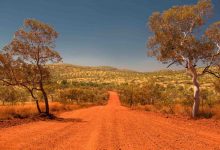Mining giant Rio Tinto has signed a green power deal with the Yindjibarndi Energy Corporation (YEC) as it seeks to roll out a series of solar, wind and battery projects to replace the gas-fired generators its huge iron ore mines currently depend on.
The memorandum of understanding (MOU) is for projects on Yindjibarndi country in the Pilbara region of Western Australia, and will enable the two companies to will explore wind, solar and battery energy storage systems on Yindjibarndi land that is close to Rio Tinto’s power lines.
Rio Tinto needs about 600-700MW of renewable power to displace most of its gas use from four gas-fired power stations in the Pilbara. The initial focus, however, is for a 75-150MW solar farm that can get up and running quickly.
YEC was launched in July by the Yindjibarndi Aboriginal Corporation (YAC) and Philippines renewables developer Acen Corporation. It wants to develop around 750MW of wind, solar and batteries on Yindjibarndi Ngurra (country) where the YAC holds exclusive possession, the strongest form of native rights.
Rio Tinto, meanwhile, is also still dealing with the fallout from its destruction of two shelters in the Juukan Gorge on the lands of the Puutu Kunti Kurrama and Pinikura people in 2021, and damage caused last month to a rock shelter from a blast at its Nammuldi operations.
“Yindjibarndi Ngurra is ideally suited to developing renewable energy generation and our people are encouraged by Rio Tinto’s interest in building this capacity with us,” said YAC CEO Michael Woodley.
“This will strengthen our existing partnership and provide long term benefits for our community, while also ensuring that we can protect and preserve the areas of cultural, spiritual and environmental significance within our Ngurra.”

ACEN International CEO Patrice Clausse noted that the strength of the YEC partnership lies in the deep-rooted connection of the Yindjibarndi people with their land.
“It is the perfect blend of traditional significance and modern technology, designed to harness the limitless potential of the Pilbara’s sun and wind,” he said.
“Together, we are crafting an energy future that is not only renewable, but also renewing, by empowering local communities and contributing to a greener future.”
The agreement that led to YEC ensures Yindjibarndi approval of all proposed project sites, Yindjibarndi equity participation of 25 – 50 per cent in all projects, preferred contracting for Yindjibarndi-owned businesses, and training and employment opportunities for Yindjibarndi people.
YEC is targeting a second stage of 2GW-3GW of combined wind, solar, and battery storage.
Court battle ongoing
The Rio Tinto MoU comes as a Yindjibarndi court battle with rival miner Fortescue continues next month.
The YAC is claiming up to $500 million in royalties from Fortescue, in a 16-year court battle over the company’s Solomon iron ore mining hub, which was built without traditional owner permission.
The hub is made up of the Firetail, Kings Valley and Queens Valley iron ore mines and has a production range of 65 to 70 million tonnes each year.
When Fortescue began negotiations with the YAC it offered $4 million a year in royalties and $6 million for housing, training and employment programs – the YAC wanted the standard Pilbara 0.5 per cent of future royalties.
The miner began operations without an agreement in place with the YAC, which in 2003 had their non-exclusive native title rights recognised by the federal court and exclusive rights recognised in 2017.
The Federal Court will hear closing submissions in early 2024.
Mining giants scrabble for green energy credentials
Mining giants are being scrutinised over their green credentials, or lack of, and those in the Pilbara are trying to harness the area’s natural solar benefits to make a dent in Scope 1 and Scope 3 emissions.
Rio Tinto has a goal to reduce both by 50 per cent by 2030 across its whole global operation, with a budget of $7.5 billion earmarked for that cause.
“The Pilbara is blessed with abundant year-round sunshine and strong winds at night, making it one of the most attractive places in the world to harness solar and wind power for energy generation,” said Rio Tinto Iron Ore CEO Simon Trott.
“We recognise we have a large carbon footprint in the Pilbara and are exploring a number of innovative solutions to help address this, including future collaborations with other Traditional Owner groups in the region.”
Traditional owners like Yindjibarndi, as well as others such as Larrakia Nation and the Jawoyn Association which signed a similar deal with developer Octopus Australia, are likely to be key as Pilbara miners shift en masse to renewables.
In August, a group of miners including BHP Rio Tinto, oil and gas majors Woodside, BP, and Atco, local energy groups such as Horizon Energy and Alinta, Fortescue Metals and Roy Hill, agreed to stop building out a “feudal” network of their own electricity grids.
Instead, they will collaborate and share their grids to cut costs, and lower emissions by facilitating the construction of wind, solar and storage.
The rise of the likes of YEC and Acen, itself a subsidiary of Philippine conglomerate Ayala Group which has a goal of making it into the largest listed renewables platform in Southeast Asia, is likely to see those miners contract Traditional Owners to provide the renewables rather than build those resources themselves.











